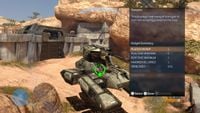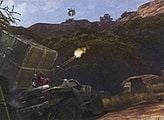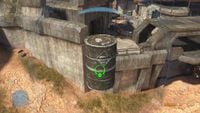Forge
From Halopedia, the Halo wiki
Forge is a Halo 3 gameplay mode that allows for both playing and designing multiplayer maps.[1][2]
Background
Forge allows players to customize, save, and share maps for Custom Games. Maps altered in this manner are referred to as map variants, and possible alterations include the modification of player spawn points, weapon spawn points, vehicle spawn points, and the addition of scenery -- items such as Crates, Fusion Coils, Grav Lifts, Teleporters, and various other items, most of which are decorative, rather than functional in nature.
In addition to functioning as map editor, Forge is also a play space. Up to eight players can be on a given map at a time, shifting back and forth between their chosen multiplayer model (Player Mode) and the Edit Mode model (a Monitor) by pressing Up on the D-Pad. There is also a setting that, if enabled, prevents all but the party leader from entering Edit Mode. Players can play actual games in Forge; experiment with Forge's features; kill each other; play Slayer where each team designates a Monitor to supply weapons, vehicles, equipment and cover on the fly; and do other things that aren't accepted in normal Multiplayer. Maps created in Forge can also be saved and then played in Custom Games.
There are, however, some limits when placing items in Forge. The most obvious limit is the set of items permitted in a map -- specific items are only allowed in specific maps. As an example, Hornets and Scorpions cannot be placed in The Pit, and Deployable Covers may not be placed in Sandtrap. There are also varying limits on how many of each item can be placed; while you can usually place up to thirty-two Frag Grenades, you can only place two Scorpions when they are available on a map.
The amount of items you can drop is also regulated by an economy budget system.[3] Different objects are assigned to different values. This is to keep you from overloading maps and using an excessive amounts of memory. Deleting items that are already on the map will free up more money for other items. The spending limit is merely a counter to help the player gauge how much they can place on the map at a given time; no real currency is used.
As revealed in Bungie's 8/27/07 Podcast, you can add items in Forge that aren't available in unmodified maps. One example is the Custom Powerup, an alternative to the Overshield or the Active Camouflage. This yellow power-up's effects can be modified when setting Custom Game options, with such customizations including the movement speed and weight of the affected player, their shielding and camouflage strength, and even the color of their armor. Effects aren't limited to one or two at a time, but rather a number of effects can occur simultaneously. The hosts described it as equivalent to an "instant juggernaut." Unfortunately, Custom Powerup settings cannot have default settings added at all, let alone on a per-map-variant basis.
A variety of Forge-specific settings can be altered by the party leader while in the Forge Lobby. As an example, players in Edit Mode can be granted more (or less) health and shielding as well as varying levels of Active Camouflage -- editors can even be granted near or total invulnerability.
The Halo 3 Heroic Map Pack introduced a map called Foundry, whose scenery and layout is almost entirely composed of movable and removable Forge objects. The Mythic Map Pack introduced Sandbox, a massive map that is commonly referred to as the ultimate forging map with a wide variety of scenery to choose from -- including every weapon and vehicle in the game, except for the Sandtrap exclusive vehicle, the Elephant.
Restrictions
The player has an object limit and a budget that varies from map to map, but the highest encountered budget is located on the map Sandbox, with a grand total of 1500 credits. All maps, however, have a maximum limit of 640 items.[4] The 640-item limit behaves somewhat oddly; removing items that are in the map by default does not free up more of the 640 "slots", so when editing large maps like Sandbox, it is best to move all default items to the side instead of deleting them and trying to replace them when you need them later.
Furthermore, Campaign objects, enemies, friendlies and “bots” cannot be added to map variants, and the basic geometry of the map cannot be altered.[5]
Forge Filters
- Main article: Forge Filters
Forge filters, referred to in-game as FX, are objects listed in scenery which came in the Legendary Map Pack maps, Cold Storage, and the Mythic Map Pack that change the camera settings. All the filters are as follows:
- Juicy - Everything is bright, vivid and colorful. Saturation is increased.
- Colorblind - Everything is displayed in grayscale.
- Gloomy - Everything is dark, shady, and somewhat desaturated.
- Nova - Everything is extremely bright and blurry, though really dark shadows look quite sharp.
- Old Timey - Everything looks like an old Western movie -- the contents of the screen are displayed in sepia tones and are even given a flickering effect, making the screen resemble an old film projector.
- Pen and Ink - Scenes are displayed as if they were drawn using an inkpen. Bright areas tend to look more like a grayscale version of the Nova filter.
It was revealed that the filters were added for better experiences in gameplay, making interesting screenshots, and for making machinima. The Juicy filter helps with seeing through the Energy Blockers, as does the Old Timey filter.
Should more than one of these filters be spawned at one time, the effects will merge to create an entirely new effect. Combining all of the effects reduces visibility to the point where it is impossible to see.
Trivia
- The three most popular maps for Forge are Foundry, Avalanche and Sandbox, most likely because of their large, open spaces and the fact that you can put nearly anything on Foundry and Sandbox.
- If you fire your weapon and then immediately enter Edit Mode, then upon returning to Player Mode, you may find that you've lost no ammo.
- If you catch on fire (from a Firebomb Grenade or the Flamethrower) and then enter Edit Mode, you will take no damage. Upon returning to Player Mode, however, you'll find that the fire was "preserved" -- you will once again take damage.
- The same trick can be used to delay the detonation of a grenade when you've been stuck. You can even delay the throwing of a grenade by entering Edit Mode immediately after pressing LT.
- It also applies to any momentum that you've gathered while in Player Mode -- if you jump into a Grav Lift, enter Edit Mode, move away, and then return to Player Mode, you will fly through the air.
- The Elephant cannot be spawned by editors due to its size, potential for lag, and specific purpose on Sandtrap.
- Forge keeps track of stats and kills.
- Created map variants can be saved and shared with the community. Also, if your creation is liked by Bungie, they will put it up to be downloaded by other players for use.
- The idea of Forge was taken from Marathon: Infinity, which also has a map editor named Forge. However, there are multiple differences: Marathons Forge was a separate application, acting as a 'pure' map editor in conjunction with another application, Anvil, which edited physics, sounds and shapes files. On the other hand, Halo 3s Forge is merely a separate gametype that allows for the spawning and repositioning of objects.
- Forge bears resemblances to Sapien, a program in the Halo Custom Edition Editing Kit.
- Some weapons may be purchased at no cost if they were originally on the map and are not deleted. However this will leave you with a penalty making it so that you need to sell the same amount you have spent under zero to reach zero again and make money again.
- Even when Edit Mode is restricted to "Party Leader Only", a programming mistake allows other players to enter Edit Mode through the start menu.
- If you stack both Elephants on top of each other and then put as many large objects (tanks) as you can on top the bottom, the Elephants will have reverse gravity.
- Through a glitch, it is possible to wield weapons while in Edit Mode. [6]
- During lag or a glitch, it is possible to see the small blueish-white tear drop shaped orbs (item spawn points) that denote where an object has been placed while in Player Mode. When this happens, the spawn points can be interacted with while in Player Mode. If you shoot or melee them, you will hear the same sound that plays when shooting or beating a shield door.
- The codename for the map making software for the first Halo game was called Forge before release.Template:Fact
- When you are in Edit Mode, the reticule in the center of the screen appears to be the Marathon symbol. This is probably due to the fact that the eyes of the Monitors resemble the same symbol.
- It has been confirmed that full Forge features will be available for the multiplayer maps for the upcoming Halo 3 expansion, Halo 3:ODST.Template:Fact
- It is unknown why you cannot place certain weapons on certain maps, but it is probably due to balancing. Vehicles would be unable to evade Missile Pods in indoor maps, and large vehicles like Wraiths and Scorpions might not even fit inside of indoor maps with small doors or rooms.
Related Articles
External Links
Images
- Forge1.jpg
A Monitor spawning Crates on High Ground.
- Forge2.jpg
The Forge Menu.
- Forge4.jpg
Spawning Crates, Barrels and Fusion Coils.
- Forge5.jpg
Reaching the Tower.
- Forge7.jpg
A Scorpion on High Ground.
- Forge lotsofvehicles.png
Many vehicles on Sandtrap.
- Mediaf.jpg
A Spartan shooting at a Monitor.
- 1208475723 29535420-Medium.jpg
The fun never ends with Forge!
- 26034885-Full.jpg
Using weapons and equipment, players can create characters from anywhere! Such as this Mario creation.
Sources
- ^ Bungie Weekly Update 8/17/2007
- ^ http://www.bungie.net/News/content.aspx?type=topnews&link=h3forgebasics
- ^ http://www.bungie.net/News/content.aspx?type=topnews&link=h3forgeobjects
- ^ http://www.bungie.net/News/content.aspx?cid=17271
- ^ 2008-22-08, Bungie Weekly Update: Tying Up Loose Ends. Accessed on 2008-22-08
- ^ Halo 3 Weapon Forge Glitch (YouTube Tutorial)


